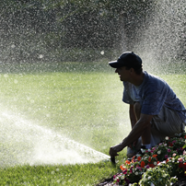Irrigation Maintenance Tips for your Property
Considering the fact that the irrigation systems are specifically designed to be low maintenance, a lot of those who own a property think that it wouldn’t be of much harm to leave it as is. That’s not true at all because even the sturdiest equipment can eventually wear out. Furthermore, a periodic inspection throughout the irrigation season is a great way to prevent and reduce any possible issues. This means your lawn would look at its best with minimal care needed. 8 Tips for Maintaining Your Irrigation 1. Have a Water Audit If possible, you should hire a Certified Landscape Irrigation Auditor who can give your property a complete water audit. This would cover the entire property, as well as the irrigation system’s reach. After which, you’ll be receiving a report that states where exactly the water is going, and if your irrigation system is operating efficiently 2. Have an Older Irrigation System Re-calibrated Getting a sprinkler system retrofitted is a very good investment. Moisture sensors, nozzle upgrades, and smart technology work in hand to increase your system’s efficiency, which will save you a lot of money in the long run. 3. Pay Attention to the Irrigation Sprinkler Heads This should be done, at a minimum every other week. Walk throughout your property and see if all the sprinkler heads are in good condition and working. Don’t worry; this isn’t difficult at all because most controllers have a test cycle. All you have to do is set the timer to have it “tested.” The timer would run for a couple of minutes for each zone. There will also be short pauses between zones that would allow you to check the heads that seem to be not working. 4. Make Sure the Heads Aren’t Broken Due to the fact that sprinkler heads are hard to see, a head that isn’t retracting properly could accidentally get run over by a lawn mower. Additionally, if water is shooting up where the sprinkler head should be, then there’s a possibility that the head (or nozzle) is broken. Have this replaced immediately to prevent the problem from getting worse. 5. The Heads Should Not Be Clogged Hard water is often the culprit of clogged rotor nozzles and sprinkler heads. The mineral, dirt, and mulch buildup may prevent the water from discharging properly. In order to prevent this from happening, you should check the screen inside the stem of the spray head, and clean it thoroughly. In case the orifice is plugged, you’ll probably need to push out the clogged matter using a screwdriver, awl, or similar tool similar. If this doesn’t work, then you should replace the head. 6. Consider Hydrozone Landscaping For those whose landscapes aren’t divided into hydrozones yet, now is the perfect time for consideration. Have your irrigation system redesigned and reinstalled. Hydrozoning entails grouping plants together that should be watered equally. For instance, drought-tolerant plants shouldn’t be paired with annuals because they have different water needs. 7. Don’t Neglect Mulching Mulching is important, because you wouldn’t use much water if your landscape beds are already mulched. The good thing about this is that, mulch is known for retaining moisture longer, giving the plants the nutrients and protection it needs. 8. Watering Should be Done in the Wee Hours of the Morning It’s important that the irrigation times are set accordingly. Generally, set your timer so that your system operates between 2:00 am and 6:00 am. By doing this, your plants will benefit from getting water during the early hours because there’s usually less wind. Guest writer for this month...
Read MoreRainwater Harvesting for 2017
Old practices now new ideas… Rainwater harvesting dates back to early civilizations, however in 2017 we see the cost of water driving the interest in collection of rain water to the forefront in building designs. From large commercial buildings to residential design, the incorporation of collecting water has seen a wide variety of systems developed, and varied applications on successfully recycling water into our environment. You can incorporate a simple rainwater collecting tank off your home roof collection downspout, or to large scale underground holding tanks and pumps for large commercial applications. Harvesting Components Understand the basic components to every rainwater harvesting system: Filtration – to collect the water you must first plan to filter and remove debris as the rainwater is coming off the roof or collecting surface Sanitation – for large scale and public collection sites you will need to consider sanitation to kill algae, parasites or other pests that may enter the storage unit Chlorination – for simple residential systems the addition of chlorine may solve most algae or similar issues Water Storage System – from barrels, large steel tanks, underground storage…correctly sizing the storage for the site collection is key to success Applying or using Harvested Water – Simple gravity feed or pumping systems with full monitoring and controls is available depending upon size of system For ease and simplicity for most residential installations we recommend working with complete kits available through Kenney Outdoor Solutions and Atlantic Water Gardens. These kits, complete with submersible on-demand pumps provide everything you need to store and distribute up to 1000 gallons of harvested water. Rainwater Harvesting Benefits As water conservation continues to be a key role in reducing our total consumption of our valuable resource of water consider the following benefits of Rainwater Harvesting is meeting your water conservation goals: 1.Easy to maintain- the overall cost of installation and ongoing maintenance is minimal and easy to maintain making it an easy option to incorporate with most residential or commercial irrigation designs. 2.Reducing water utility bills – water collected by the systems can be used for several non-drinking functions and thereby reducing the use of city water and lowering monthly water bills. Rainwater is free from many chemicals and makes it suitable for irrigation and watering gardens. 3.Reduces demand on groundwater-with increased population and higher demand for water, in many areas there are concerns on depletion of precious ground water supplies. To learn how a rainwater harvesting system might be incorporated into your next irrigation design Name(required) Email(required) Company Name(required) Comment(required) Submit...
Read MoreTools and Technology: Irrigation Design Series
Basic considerations for contracting irrigation design services include provider availability with design capabilities needed, independence from affiliation with product suppliers, cost of services, and contracting method (lump sum, hourly, etc.). There are a variety of independent irrigation designers located in various US regions. To find an irrigation designer new you, check out ASLA’s Firm Finder or the American Society of Irrigation Consultants (ASIC). Generally, expect to pay slightly more for independent irrigation design consultants compared to using a contractor or getting design assistance from an irrigation manufacturer. The benefits include higher quality, freedom to select any product best suited for the design needs, attention to detail, thorough information about total lifecycle cost of the system, full spectrum of maintenance considerations, and a wide range of bids for installers. The contractor or irrigation manufacturer could place limits on the range products, not be open to substitutions, unable to approve using equivalent performance products, and might be tied to fewer installers. In some cases, shortcuts would include using a performance specification. Examples include placing the burden of pipe sizing based on a friction loss table on the field contractor, or pump sizing (flow, pressure, dynamic, and static head) and pump control definition delegated to the pump fabricator instead of being set by the designer. Examples of a subconsultant agreement for irrigation design are available by contacting a member of the Irrigation Association (IA) or the American Society of Irrigation Consultants (ASIC). Considerations for self-performing include knowledge of hydrology, hydraulic design fundamentals, up-to-date product performance knowledge, and staff capability. Advantages include more control over cost to produce the design, greater ability to make changes during design, bid phase or construction, and a long term ability to build knowledge and skill with each completed project; compared to contracting with others for irrigation design. For water conservation, it can be a sales advantage for securing future projects to track water savings cumulatively per project. These records can be maintained from a consultant designer or by self-performing irrigation design. Regular training sessions in irrigation design for staff are available from Irrigation Association (IA). Product information can be secured from national or regional product reps and by attending ASLA Chapter or ASLA Annual meeting and EXPO events. Factors common to both delivery methods (self-perform or contract for services) include risk and liability control for design, establishing the design life, setting the minimum required design criteria (usually set by state, regional, county or local agency requirements plus irrigation industry professional society standards), and setting performance criteria set by the designer above and beyond the minimum codes; including ASIC, IA, LEED, LID, or SITES for water conservation and lifecycle cost benefit considerations for longevity of system service. First, set high expectations for project outcomes such as protection of fresh water natural resources, disaster avoidance, and reduced potential for litigation or third party claims. Next, if you can’t meet your own high expectations using in-house irrigation design, then seek professional assistance from other providers. Documented litigation and paid claims settlements show irrigation designs have caused or contributed to loss of life, personal injury, plus direct or consequential property damage. Impacts are from too much (or not enough) water applied, overspray on vehicle travel areas or structures, and a wide array of technical problems; product failures (tolerable levels and unusual levels), over pressure, design errors, system leaks, properly designed system not inspected or tested after improper installation, irrigation system at a storm water facility enabling cross connection contamination due to backflow in the public water supply system. A failed irrigation system that compromises the top, face, or toe of a...
Read MoreLooking Ahead…the Federal Role in River Management will change
Professional Practice Network Update Sharing with you the most recent newletter from ASLA and the Water Conservation PPN. As part of this series we see our very own, Jim Davis, PLA, ASLA, CID of Landtech Design based in Indianapolis, Indiana. Jim is collaborating on the twelve part technical series on irrigation design based on his robust practice in the Midwest, and share his knowledge in his role as Midwest Technology Officer of ASLA’s Water Conservation PPN. Last month’s edition provided a look at the start-up of large federal water programs from 1930 to 1940. The State of California just experienced flooding on 40 rivers ending a long drought in 42% of the state. Snowpack is at 178% in Sierra Nevada mountains contributing 30% of water supply. A $15.4 billion state bond package is in progress mostly in planning and design phase. If large scale water storage areas and groundwater recharge projects for water conservation had been in place on 40 rivers ahead of January, 2017, California’s long term water supply would be in better condition for meeting challenges ahead. This month, we look at a main catalyst of the entire large federal control of U.S. rivers for the past 90 years; the great flood of 1927. This month’s recommended best seller book is “Rising Tide” (1997, Simon & Schuster) by John M. Barry. The book traces river delta cotton plantation monoculture decline after the great flood, plus a series of interventions by (then) Secretary Herbert Hoover ushering in the next 90 years of USACE agency staff shaping the fate of the Mississippi River. After Hoover’s term as President, monumental control of river water resulted from massive increases in the size of the federal government. Programs of the 1930s brought forward the Grand Coulee Dam on the Columbia River, now part of the Bonneville Power Authority’s network of dams; the Hoover Dam (renamed Boulder Dam) on the Colorado River, reallocated water across Colorado, Arizona, Nevada, and California; the Norris Dam and other dams within the Tennessee Valley Authority’s network of hydrodams served the South East US. Hubris in the federal control rivers changed the fate of the nation bringing unprecedented US economic wealth at great costs and environmental impacts. With US federal debt at $20 trillion, the federal government will become smaller starting in 2017. Private sector, state, and local agencies can step up to help meet large scale water infrastructure funding needs. Rod D. Martin’s book review of “Rising Tide” in the year 2000 sums up how the federal government changed to respond to rivers the US: “No one remembers the 1927 flood, or even that it happened; but it was the events surrounding that single event which more than anything else gave us modern America, and John Barry’s book is essential to understanding it. Obviously the book gives a full account of the flood itself, of the history of the river and of the delta, of the people who carved a nation out of wilderness and who lived and died in the catastrophe; without a doubt, Barry does all this, and does it in gripping style: the book is hard to put down. But Barry does far more. In telling the story, he shows how a heretofore anti-socialist America was forced by unprecedented circumstance to embrace an enormous, Washington-based big-government solution to the greatest natural catastrophe in our history, preparing the way (psychologically and otherwise) for the New Deal. He shows how this was accomplished through the Republican . . .Herbert Hoover, who would never have become President without the flood. . . . It is an amazing...
Read MoreTribute to Tom Lee
Paying tribute to Tom Lee for the many contributions he made to the Irrigation Industry, Landtech Design and to Kenney Outdoor Solutions.
Read MoreIndianapolis Motor Speedway gets new look
Gentlemen..and Ladies Start Your Engines 100th Anniversary for Indy 500 Race The city of Indianapolis is busy getting ready to host the 100th running of the Indianapolis 500 this year on Sunday, May 29th, 2016. As you can imagine these projects are in full swing and nearing completion. All of which will give the Indianapolis Motor Speedway a new look and yet hold on to the history and tradition that makes this event so popular. Landtech Design Irrigation at the start Indianapolis Motor Speedway embarked on a $90M Project to upgrade, replace and improve the entire experience for visitors to IMS. The roundabout that was recently completed outside Turn 1 will now gain the pedestrian plaza in what has been termed the new “Kodak Moment” entranceway to The Greatest Spectacle in Racing. Highlights include: Large pedestrian Plaza with checkered-flag patterns in the paving, and dramatic lighting of the architectural features and plantings Main pedestrian entrance to IMS and updated grandstands and seating Landtech Design Irrigation has been involved from the early design inception to incorporate the irrigation with the complex landscape planting developed for the Plaza. Countdown to Race Day Construction is now entering the final stages and the landscape and irrigation portion of the project is underway. Becker Landscaping in Indianapolis is the landscape contractor for the project and they are busy with the many aspects that will give the project the finishing touch. When the green flag is dropped for the start of the race we know that cameras will be on the cars racing into the first turn, but also the cameras will be showcasing the tremendous work put into this major project. The largest single-day sporting event in the world and Landtech Design Irrigation and Kenney Outdoor Solutions have played a part in that project. Be sure to keep Landtech Design Irrigation in mind for any projects that you are undertaking, whether they are large scale or small we have the team available to provide you with designs incorporating the latest in technology and water...
Read More







